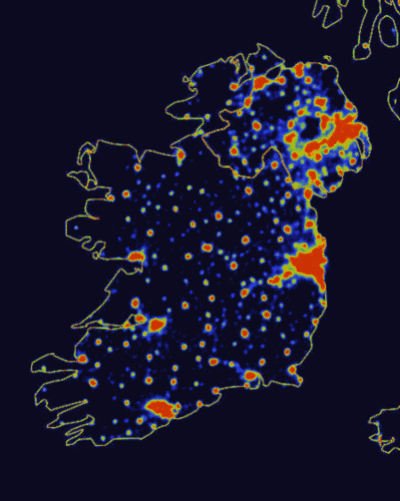A PHYSICS PROFESSOR at Trinity College Dublin is hoping to start a discussion about the amount of light pollution produced in Ireland.
Professor Brian Espey and his colleagues measured light falling on the ground at locations away from directly-illuminated areas (such as those with streetlights), and recorded the light scattered back onto the ground from the air.
Measurements were taken on clear nights over a 1,000 square km area from Dublin City Centre southwards into the Wicklow Hills.
Unsurprisingly, light from Dublin city dominates the natural sky background even in heritage sites such as Glendalough, some 45 km away – as well as other parts of the Wicklow Mountains National Park.
Espey and his team estimates that over 2.2 GWh (2.2 million “units”) of electricity is “wasted” in providing diffuse illumination of areas such as back gardens, public parks, woods and mountains, at a cost of about €300,000 annually.
Scaled up by the light emission of other Irish cities, this amounts to a cost of 3.3 GWh, or an annual burden of €460,000, but these measurements underestimate the true figures as light escaping directly to space has not been factored in.
“When we look at images from the International Space Station, such as those tweeted by Commander Chris Hadfield when he flew over Ireland, we generally do not think that the light that a few astronauts see at 400 km above the Earth is just a small sample of the total that is outgoing to space, never to return,” Espey stated.
Public lighting accounts for about 15% to 35% of a local authority’s energy use.
According to research carried out by the Sustainable Energy Authority of Ireland (SEAI), the 420,000 or so streetlights in Ireland use a total of 205 GWh of electricity annually, which costs €29 million and produces 110,000 tonnes of carbon dioxide.
Espey’s team said as much as 20-30% of this energy “could be wasted through poorly-designed or inefficient lighting and the illumination of areas where light is not needed”.
The professor said this is also negatively impacting the environment an people’s health.
Humans – just like other animals and plants – have been conditioned over millions of years to rely on circadian rhythms, which are controlled by natural light-dark, day-night transitions. If the environment remains brightly lit then the night-time mode of repair and replenishment cannot occur as is required, and potentially harmful free radicals build up in our systems.
Espey said local authorities “are aware of light waste and pollution, but there is still room for improvement and more could embrace improved light pollution controls as part of their environmental agenda”.
He noted that most public lighting in Ireland is “unmetered and uses relatively old technology”, but said the push towards newer lighting types such as LED technology “could see the situation improve in the medium term”.
Espey added that these issues should be looked at in detail “before the next cycle of building commences”.
Security for the public
A spokeswoman for Dublin City Council said the biggest source of light pollution is from low pressure sodium lights of which DCC uses about 22,000. It is proposed to replace all of these lights over the next few years with LED lighting.
This will have a big impact on light pollution. The city has approximately 45,000 lights and the remaining 23,000 lights do not have the same light polluting effect as the low pressure sodium [lights]. So, as far as light pollution is concerned, the council has a plan in place to reduce a large amount of the light pollution problem.
She noted that street lights affords city residents a ”sense of security”, adding: “LED lighting is more efficient at delivering light to where it is required, but this light is also reflected back up into the sky and will also cause light pollution. So even the most efficient of lighting schemes will produce some light pollution.”
DCC spends approximately €3.6 million per year on energy supplied to street lights. The move to LED technology, which is expected to be completed in about five years, will decrease this expenditure by 50%.
Espey will present his findings in public during next week’s Trinity Week – the theme of which is ‘light’. More information is available here.
Source: The Journal.ie






